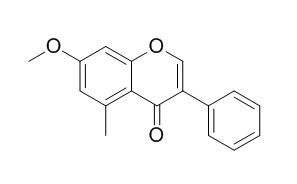5-Methyl-7-methoxyisoflavone
5-Methyl-7-methoxyisoflavone is used by bodybuilders for its ergogenic properties.
Inquire / Order:
manager@chemfaces.com
Technical Inquiries:
service@chemfaces.com
Tel:
+86-27-84237783
Fax:
+86-27-84254680
Address:
1 Building, No. 83, CheCheng Rd., Wuhan Economic and Technological Development Zone, Wuhan, Hubei 430056, PRC
Providing storage is as stated on the product vial and the vial is kept tightly sealed, the product can be stored for up to
24 months(2-8C).
Wherever possible, you should prepare and use solutions on the same day. However, if you need to make up stock solutions in advance, we recommend that you store the solution as aliquots in tightly sealed vials at -20C. Generally, these will be useable for up to two weeks. Before use, and prior to opening the vial we recommend that you allow your product to equilibrate to room temperature for at least 1 hour.
Need more advice on solubility, usage and handling? Please email to: service@chemfaces.com
The packaging of the product may have turned upside down during transportation, resulting in the natural compounds adhering to the neck or cap of the vial. take the vial out of its packaging and gently shake to let the compounds fall to the bottom of the vial. for liquid products, centrifuge at 200-500 RPM to gather the liquid at the bottom of the vial. try to avoid loss or contamination during handling.
Phytomedicine.2021, 2(82):153452
In Vitro Cellular & Developmental Biology - Plant2022, 58:972-988.
Microchemical Journal2014, 203:110804.
Evid Based Complement Alternat Med.2016, 2016:4357656
Oncotarget.2017, 9(3):4161-4172
Int J Med Sci.2020, 17(5):626-631
Asian Journal of Chemistry2014, 26(22):7811-7816
J Appl Biol Chem.2024, 67:47,337-343.
Korean Herb. Med. Inf.2020, 8(2):233-242.
Foods. 2022, 11(23):3905.
Related and Featured Products
Sci Rep. 2017 Apr 7;7:45780.
A staged screening of registered drugs highlights remyelinating drug candidates for clinical trials.[Pubmed:
28387380 ]
There is no treatment for the myelin loss in multiple sclerosis, ultimately resulting in the axonal degeneration that leads to the progressive phase of the disease.
METHODS AND RESULTS:
We established a multi-tiered platform for the sequential screening of drugs that could be repurposed as remyelinating agents. We screened a library of 2,000 compounds (mainly Food and Drug Administration (FDA)-approved compounds and natural products) for cellular metabolic activity on mouse oligodendrocyte precursors (OPC), identifying 42 molecules with significant stimulating effects. We then characterized the effects of these compounds on OPC proliferation and differentiation in mouse glial cultures, and on myelination and remyelination in organotypic cultures. Three molecules, edaravone, 5-Methyl-7-methoxyisoflavone and lovastatin, gave positive results in all screening tiers. We validated the results by retesting independent stocks of the compounds, analyzing their purity, and performing dose-response curves. To identify the chemical features that may be modified to enhance the compounds' activity, we tested chemical analogs and identified, for edaravone, the functional groups that may be essential for its activity.
CONCLUSIONS:
Among the selected remyelinating candidates, edaravone appears to be of strong interest, also considering that this drug has been approved as a neuroprotective agent for acute ischemic stroke and amyotrophic lateral sclerosis in Japan.
J Pharm Biomed Anal. 2014 Aug 5;96:127-34.
UPLC-ESI-Q-TOF-MS(E) identification of urinary metabolites of the emerging sport nutrition supplement methoxyisoflavone in human subjects.[Pubmed:
24742771 ]
Methoxyisoflavone (5-Methyl-7-methoxyisoflavone) is a synthetic isoflavone used by bodybuilders for its ergogenic properties. A recent study demonstrated that methoxyisoflavone metabolites can induce false-positive results in urinary immunoassay screening tests for cannabinoids, and only one metabolite has been identified. To improve the knowledge on the metabolic pathways of methoxyisoflavone, ultra-performance liquid chromatography quadrupole time-of-flight mass spectrometry (UPLC-Q-TOF) was applied.
METHODS AND RESULTS:
Urine samples were obtained from methoxyisoflavone regular users. After enzymatic hydrolysis and liquid-liquid extraction, the samples were analyzed by UPLC-Q-TOF fitted with an electrospray ionization source (ESI) operating under positive ion mode. Mass data were acquired with the MS(E) method. Five metabolites were identified. Those were divided into two metabolic pathways, depending on whether the B ring hydroxylation was preceded or not by the O-demethylation of the methoxy group. The MS(E) mass spectra of methoxyisoflavone and its metabolites are specific of isoflavones structures and revealed 1,3 retro Diels-Alder fragmentation and double CO loss. Losses of small neutral molecules CO and H2O, and radical CH3, typical of flavonoids, were also observed.
CONCLUSIONS:
This study illustrates the capacity of the sensitive UPLC-Q-TOF analytical system, combined with the MS(E) method of collection of fragmentation data, to rapidly elucidate the unknown xenobiotics metabolism.



